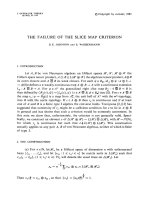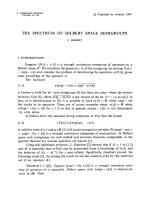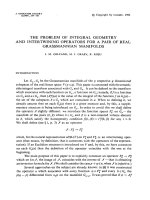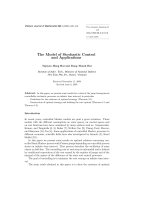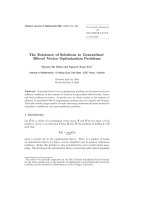Báo cáo toán học: "The cube polynomial and its derivatives: the case of median graphs" pps
Bạn đang xem bản rút gọn của tài liệu. Xem và tải ngay bản đầy đủ của tài liệu tại đây (122.86 KB, 11 trang )
The cube polynomial and its derivatives: the case of
median graphs
Boˇstjan Breˇsar
∗
FEECS, University of Maribor
Smetanova 17, 2000 Maribor, Slovenia
Sandi Klavˇzar
†
Department of Mathematics, PeF, University of Maribor
Koroˇska cesta 160, 2000 Maribor, Slovenia
Riste
ˇ
Skrekovski
‡
Department of Mathematics, University of Ljubljana
Jadranska 19, 1111 Ljubljana, Slovenia
Submitted: Jun 21, 2001; Accepted: Dec 27, 2002; Published: Jan 10, 2003
MR Subject Classifications: 05C30,05A15,05C12
Abstract
For i ≥ 0, the i-cube Q
i
is the graph on 2
i
vertices representing 0/1 tuples of
length i, where two vertices are adjacent whenever the tuples differ in exactly one
position. (In particular, Q
0
= K
1
.) Let α
i
(G) be the number of induced i-cubes of
agraphG. Then the cube polynomial c(G, x)ofG is introduced as
i≥0
α
i
(G)x
i
.
It is shown that any function f with two related, natural properties, is up to the
factor f(Q
0
,x) the cube polynomial. The derivation ∂G of a median graph G is
introduced and it is proved that the cube polynomial is the only function f with
the property f
(G, x)=f(∂G,x) provided that f(G, 0) = |V (G)|.Asthemain
application of the new concept, several relations that widely generalize previous
such results for median graphs are proved. For instance, it is shown that for any
s ≥ 0wehavec
(s)
(G, x +1)=
i≥s
c
(i)
(G,x)
(i−s)!
, where certain derivatives of the cube
polynomial coincide with well-known invariants of median graphs.
∗
Supported by the Ministry of Education, Science and Sport of Slovenia under the grant Z1-3073-
0101-01.
†
Supported by the same Ministry under the grant 101–504.
‡
Supported by the same Ministry under the grant Z1-3219.
the electronic journal of combinatorics 10 (2003), #R3 1
1 Introduction
Median graphs present a natural generalization of trees and hypercubes. It is therefore
not surprising that they have been independently introduced several times [1, 12, 15].
These graphs are closely related to distributive lattices and graph retracts; see Avann
[1], Bandelt [2], and Duffus and Rival [5]. Mulder [12, 13] proved that a graph G is a
median graph if and only if G can be obtained from K
1
by the so-called convex expansion
procedure. A step in such procedure can, intuitively, be described as follows. Cover a
graph H with two subgraphs H
1
,H
2
such that the intersection X of the cover is convex,
take the disjoint union of H
1
and H
2
and finally insert a natural matching between the
two copies of X. A similar characterization of median graphs is due to Bandelt and van
de Vel [3]. Namely, a connected graph is a median graph if and only if it can be obtained
from hypercubes by a sequence of convex amalgamations, where a convex amalgamation
consists of gluing together two graphs along isomorphic convex subgraphs. For a survey of
known characterizations of median graph see [11] and for infinite median graphs consult
[18]. Recently a surprising connection between median graphs and (bipartite or non-
bipartite) triangle-free graphs was discovered that asserts, intuitively speaking, that there
are as many median graphs as there are triangle-free graphs [8].
Let G be a median graph with n vertices, m edges, and k equivalence classes of
G with respect to the Djokovi´c-Winkler [4, 20] relation Θ. In [10] it was proved that
2n − m − k ≤ 2, and that equality holds if and only if G is a cube-free median graph.
Earlier, Soltan and Chepoi [17, Theorem 4.2.(6)] proved that
i≥0
(−1)
i
α
i
(G)=1 (1)
where α
i
(G) denotes the number of induced i-cubes of G. This result was later indepen-
dently obtained in [16], where it was also proved that
k = −
i≥0
(−1)
i
iα
i
(G). (2)
Equality (1) presents a generalization of the well-known equality “n − m = 1” for trees,
while (2) applied to trees says that “k = m”, which is another characterizing property of
trees. These two relations in turn imply the Euler-type formulas from [9, 10].
The main purpose of this paper is to present a general approach for obtaining such
equalities. The corresponding results that generalize all the above equalities are given in
the second part of the paper. To obtain these results, we introduce the cube polynomial of
agraphG as c(G, x)=
i≥0
α
i
(G)x
i
. (For other graph polynomials see [6].) We first show
some basic properties of the cube polynomial: the amalgamation, product, and expansion
properties. In fact, any function f with the amalgamation, and expansion properties is
up to the factor f(K
1
,x) the cube polynomial. Weaker conditions suffice to reach similar
conclusions if we restrict to the class of median graphs. Then we introduce the derivation
graph ∂GofamediangraphG and prove that the cube polynomial is the only function f
with the property f
(G, x)=f(∂G,x) provided that its value at x = 0 equals the number
the electronic journal of combinatorics 10 (2003), #R3 2
of vertices. In the last section we prove several relations for median graphs involving the
cube polynomial. Among others we prove that for any s ≥ 0wehave
c
(s)
(G, x)=
i≥s
(−1)
i−s
(i − s)!
c
(i)
(G, x +1).
This equality in turn implies
θ
s
(G)=s!
i≥0
(−1)
i−s
i
s
α
i
(G) , (3)
where θ
s
(G) is the number of components of the s-derivation of the graph G which by
Proposition 8 equals the s-th derivative of c(G, x) evaluated at x = −1. It is always
satisfied that θ
0
(G)=1andθ
1
(G)=k. Thus plugging s =0ands = 1 into (3) we obtain
(1) and (2), respectively.
2 Preliminaries
Let G be the set of all finite graphs. Denote by P
n
the path on n vertices, and by K
n
the
complete graph on n vertices. For i ≥ 0letQ
i
be the hypercube of dimension i, or shortly
the i-cube. Its vertex set consists of all 0/1 tuples of length i, two vertices being adjacent
whenever the tuples differ in exactly one position. Note that Q
0
= K
1
and Q
1
= K
2
.
The Cartesian product G✷H of graphs G and H is the graph with vertex set V (G) ×
V (H) in which the vertex (a, x) is adjacent to the vertex (b, y) whenever ab ∈ E(G)and
x = y,ora = b and xy ∈ E(H). It is easy to see that the Cartesian product of i ≥ 1
copies of K
2
is the i-cube Q
i
.
A subgraph H of a graph G is an isometric subgraph if d
H
(u, v)=d
G
(u, v) for all
u, v ∈ V (H), where d
G
(u, v) denotes the length of a shortest path in G from u to v.A
subgraph H of a graph G is convex if for any two vertices u, v of H all shortest paths
between u and v in G are already in H. Isometric subgraphs of hypercubes are called
partial cubes. A graph G is a median graph if there exists a unique vertex x to every triple
of vertices u, v,andw such that x lies simultaneously on a shortest u, v-path, a shortest
u, w-path, and a shortest w, v-path. Median graphs are partial cubes, cf. [7, 13]. Let M
denote the class of all median graphs.
Two edges e = xy and f = uv of G are in the Djokovi´c-Winkler [4, 20] relation Θ if
d(x, u)+d(y,v) = d(x, v)+d(y,u). Winkler [20] proved that a bipartite graph is a partial
cube if and only if Θ is transitive. Consider for instance the i-cube Q
i
.Lete ∈ E(Q
i
)
and suppose that the ends of e differ in position r,wherer ∈{1, ,i}.Thene is in
relation Θ with precisely those edges of Q
i
whose ends differ in position r. Consequently,
Θ is transitive on E(Q
i
) and consists of i equivalence classes.
Let I
n
= {1, ,n}. In the paper the inclusion-exclusion principle will be used, which
for given sets A
1
, ,A
n
says that
|A
1
∪ A
2
∪···∪A
n
| =
J⊆I
n
(−1)
|J |−1
|
i∈J
A
i
|. (4)
the electronic journal of combinatorics 10 (2003), #R3 3
3 The cube polynomial
For a graph G,letα
i
(G) denote the number of induced i-cubes of G.Notethatα
0
(G)=
|V (G)| and α
1
(G)=|E(G)|.Letc(G, x) be the generating function of the sequence
(α
i
(G))
∞
i=0
,thatis,
c(G, x)=
i≥0
α
i
(G)x
i
.
For finite graphs G, c(G, x) is a polynomial and we call it the cube polynomial of G.For
instance, let T be a tree on n vertices, then c(T,x)=(n − 1)x + n.Notealsothat
c(Q
n
,x)=(x +2)
n
and that
α
k
(G)=
c
(k)
(G, 0)
k!
. (5)
A cover C of a graph G is a set of induced subgraphs C = {G
1
, ,G
n
} of G such that
G = G
1
∪ G
2
∪···∪G
n
. We say that a cover C is cubical, if every induced hypercube of
G is contained in at least one of the graphs of C. For any subset A⊆I
n
,letG
A
be the
intersection (possibly empty and possibly disconnected) of the graphs G
i
(i ∈A).
Proposition 1 Let C = {G
1
, ,G
n
} be a cubical cover of a graph G. Then,
c(G, x)=
A⊆I
n
(−1)
|A|−1
c(G
A
,x). (6)
Proof. For i ≥ 0andj ∈{1, 2, ,n},letA
j
i
be the set of induced i-cubes of the graph
G
j
.Thenα
i
(G)=|A
1
i
∪ A
2
i
∪···∪A
n
i
|. Hence, by (4), we infer
α
i
(G)=
A⊆I
n
(−1)
|A|−1
|
j∈A
A
j
i
|.
In addition, c(G
A
,x)=
i≥0
|∩
j∈A
A
j
i
| x
i
. Therefore,
c(G, x)=
i≥0
α
i
(G) x
i
=
i≥0
A⊆I
n
(−1)
|A|−1
|
j∈A
A
j
i
|
x
i
=
A⊆I
n
i≥0
(−1)
|A|−1
|
j∈A
A
j
i
|
x
i
=
A⊆I
n
(−1)
|A|−1
c(G
A
,x) .
Because of Proposition 1 we say that a function f : G×IR → IR has the amalgamation
property if
f(G, x)=
A⊆I
n
(−1)
|A|−1
f(G
A
,x). (7)
the electronic journal of combinatorics 10 (2003), #R3 4
whenever {G
1
, ,G
n
} is a cubical cover of G.
As hypercubes are the simplest Cartesian product graphs, the cube polynomial should
behave nicely with respect to the Cartesian product. Indeed, observe that an induced
r-cube of G✷H is uniquely representable as Q
s
✷Q
r−s
,whereQ
s
is an induced s-cube of
G and Q
r−s
an induced (r − s)-cube of H. Hence, for every k ≥ 0,
α
k
(G✷H)=
k
i=0
α
i
(G)α
k−i
(H) .
From here we easily conclude:
Proposition 2 For any graphs G and H,
c(G✷H, x)=c(G, x)c(H, x).
Observe that the identity |E(G✷H)| = |E(G)||V (H)| + |E(H)||V (G)| immediately
follows from Proposition 2. We say that a function f : G×IR → IR has the product
property if for any graphs G and H,
f(G✷H, x)=f(G, x)f (H, x) .
Let G be a connected graph. The expansion G
∗
of G with respect to the cubical cover
{G
1
,G
2
} of G is the graph constructed as follows. Let G
∗
i
be an isomorphic copy of G
i
,
for i =1, 2, and, for any vertex u of G
0
= G
1
∩ G
2
,letu
i
be the corresponding vertex in
G
∗
i
.ThenG
∗
is obtained from the disjoint union of G
∗
1
and G
∗
2
, where for each u of G
0
the
vertices u
1
and u
2
are joined by an edge. (Note that, since the cover is cubical, a vertex of
G
1
\ G
2
cannot be adjacent to a vertex of G
2
\ G
1
. Note also that the intersection G
1
∩ G
2
is non-empty.)
It is easy to prove the following claim. Just observe that via the expansion the sub-
graph isomorphic to G
0
✷K
2
gives rise to new/larger hypercubes.
Proposition 3 Let G
∗
be a graph constructed by the expansion with respect to the cubical
cover {G
1
,G
2
} (over G
0
). Then c(G
∗
,x)=c(G
1
,x)+c(G
2
,x)+xc(G
0
,x).
Because of this result, the following definition seems reasonable. A function f : G×
IR → IR has the expansion property if
f(G
∗
,x)=f (G
1
,x)+f (G
2
,x)+xf(G
0
,x),
whenever G
∗
is the expansion with respect to the cubical cover {G
1
,G
2
} (over G
0
).
Theorem 4 Let f : G×IR → IR be a function with the amalgamation and the expansion
property. Then for any graph G,
f(G, x)=f (Q
0
,x) c(G, x) .
the electronic journal of combinatorics 10 (2003), #R3 5
Proof. The proof is by induction on the number of vertices of a graph. The n-cube Q
n
,
n ≥ 1, can be obtained as the expansion of the cubical cover { Q
n−1
,Q
n−1
} (over Q
n−1
).
Now, by the expansion property we have f(Q
n
,x)=(2+x)f(Q
n−1
,x). Hence,
f(Q
n
,x)=(2+x)
n
f(Q
0
,x)=c(Q
n
,x)f (Q
0
,x).
Suppose now that G is not a hypercube. Let C be the set comprising of the graphs
G−v for every v ∈ V (G). Since G is not a hypercube, C is a cubical cover and every graph
of C is smaller than G. Using amalgamation property for c, and the induction hypothesis
for graphs G
i
, we conclude that
f(G, x)=
A⊆I
n
(−1)
|A|−1
f(G
A
,x)
=
A⊆I
n
(−1)
|A|−1
f(Q
0
,x) c(G
A
,x)
= f(Q
0
,x) c(G, x).
From the above proof we can also deduce that if f has the amalgamation property
and f(Q
n
,x)=(x +2)
n
holds for every n ∈ IN
0
,thenf ≡ c.
In the case of median graphs we can strengthen the result of Theorem 4. Recall that
Mulder [12, 13] proved that a graph is a median graph if and only if it can be obtained from
K
1
by a sequence of expansions in which G
0
= G
1
∩ G
2
is always convex, cf. also [11, 14].
Corollary 5 Let f : M×IR → IR be a function with the expansion property. Then,
f(G, x)=f (Q
0
,x) c(G, x).
If, in addition, f has the product property, then either f ≡ 0 or f ≡ c.
Proof. Let f has the expansion property. The proof of the first assertion is by induction
on the number of expansion steps needed to obtain a median graph. The conclusion is
clear for G = K
1
.LetnowG
∗
be a median graph obtained by a (convex) expansion with
respect to the cubical cover {G
1
,G
2
} (over G
0
). Then,
f(G
∗
,x)=f (G
1
,x)+f (G
2
,x)+xf(G
0
,x).
From the induction hypothesis we obtain
f(G
∗
,x)=f (Q
0
,x)c(G
1
,x)+f (Q
0
,x)c(G
2
,x)+xf(Q
0
,x)c(G
0
,x)
= f(Q
0
,x)(c(G
1
,x)+c(G
2
,x)+xc(G
0
,x))
= f(Q
0
,x)c(G
∗
,x).
If f also has the product property, then, since Q
0
✷Q
0
= Q
0
,wehavef(Q
0
,x)=
[f(Q
0
,x)]
2
.Thuseitherf(Q
0
,x)=0orf(Q
0
,x) = 1. Combining this with the fact
that f(G, x)=f(Q
0
,x) c(G, x) completes the proof.
the electronic journal of combinatorics 10 (2003), #R3 6
4 Derivation graphs of median graphs
Let F be a Θ-class of a median graph and let e = uv ∈ F . Then it is well-known that F
forms a matching. Moreover, the ends of edges of F that are closer to u than to v induce
a median graph isomorphic to the subgraph induced by the ends of edges of F that are
closer to v than to u. We denote this median subgraph by U
e
.LetF(G)bethesetof
edges consisting of representatives of the Θ-classes of G. Then we define the derivation
ofamediangraphG as the graph
∂G=
e∈F(G)
U
e
,
that is, as the disjoint union of the graphs U
e
, e ∈F(G). (Note that transitivity of Θ
implies that the graph ∂Gis well-defined.) For instance, ∂ (P
n
✷P
m
) is the disjoint union
of n − 1copiesofthepathP
m
and m − 1copiesofthepathP
n
.
The reason for calling the graph ∂G“the derivation” of G is the following property.
Proposition 6 (Derivation property) Let G be a median graph. Then,
c
(G, x)=c(∂G,x). (8)
Proof. Note that for any Q
n
in G its edges lie in n Θ-classes (n ≥ 1), and the corre-
sponding graphs U
e
induce (n − 1)-cubes—altogether there are nQ
n−1
’s for each n-cube
of G. Hence, nα
n−1
(G) equals the number of (n − 1)-cubes of ∂G. In other words:
c
(G, x)=
e∈F
c(U
e
,x)=c(∂G,x).
We say that a function f : M×IR → IR has the derivation property if
f
(G, x)=f(∂G,x).
We next prove that the cube polynomial is the only function on median graphs with
the derivation property such that its value in x = 0 equals the number of vertices.
Theorem 7 Let f : M×IR → IR be a function with the derivation property, such that
f(G, 0) = |V (G)|. T hen f ≡ c.
Proof. First, since Q
0
has no Θ-classes, ∂Q
0
is empty. Thus f(Q
0
,x) is a constant, and
f(Q
0
, 0) = 1 implies f (Q
0
,x)=1. Hencef(Q
0
,x)=c(Q
0
,x).
The proof proceeds by induction on the number of vertices of a median graph. Suppose
that for any median graph H with less than k vertices we have f(H, x)=c(H, x), and
let G have k vertices. Recall that for every e ∈ E(G), the graph U
e
is a median graph.
Since U
e
has less than k vertices, f(U
e
,x)=c(U
e
,x) holds by the induction assumption.
the electronic journal of combinatorics 10 (2003), #R3 7
By the derivation properties of c and f we infer that f
(G, x)=c
(G, x). Therefore
f(G, x)=c(G, x)+C,whereC is a constant. Since f(G, 0) = c(G, 0), we obtain that
C = 0, and therefore f ≡ c.
Let us denote by M
∗
the class of all graphs whose connected components are median
graphs. Thus, G ∈M
∗
can be written as G = G
1
∪ G
2
∪···∪G
s
,whereeachG
i
is a
median graph. Then we can extend the concept of the derivation graph to the graphs
from M
∗
by setting ∂G= ∂G
1
∪ ∂G
2
∪···∪∂G
s
and also define the higher derivations
in the following way. For k ≥ 0, set
∂
k
G =
∂ (∂
k−1
G) k ≥ 1
Gk=0.
(9)
Then one can easily extend Proposition 6 to the graphs from M
∗
as well as generalize it
to the higher derivatives in the following way:
c
(k)
(G, x)=c(∂
k
G, x). (10)
5 Relations for median graphs
Throughout this section let G be a median graph with k Θ-classes. Denote by the θ
s
(G)
(s ≥ 0) the number of components in the graph ∂
s
G.Thus,θ
0
(G)=1andθ
1
(G)=k.
Recall that a graph is a median graph if and only if it can be obtained from hypercubes
by a sequence of convex amalgamations, a result due to Bandelt and van de Vel [3], cf.
also [11, 19].
Proposition 8 Let G be a median graph and s ≥ 0. Then,
θ
s
(G)=c
(s)
(G, −1) .
Proof. The proof is by induction on s, and afterwards by induction on the number
of vertices of a median graph. Suppose first that s =0. IfG
∼
=
Q
n
(n ≥ 0) then
c(Q
n
, −1) = 1 = θ
0
(Q
n
). Now assume that G is the amalgam of G
1
and G
2
over G
0
.
Then, by the induction assumption,
c(G, −1) = c(G
1
, −1) + c(G
2
, −1) − c(G
0
, −1) = 1 + 1 − 1=1=θ
0
(G).
Suppose now that the claim holds for all integers smaller than s (s ≥ 1) and for all
median graphs with less vertices than G.Sincec
(s+1)
(G, x)=
e∈F(G)
c
(s)
(U
e
,x)wecan
use the induction hypothesis for graphs U
e
and derive
c
(s+1)
(G, −1) =
e∈F(G)
θ
s
(U
e
)=θ
s+1
(G).
the electronic journal of combinatorics 10 (2003), #R3 8
Theorem 9 Let G be a median graph and s ≥ 0. Then,
c
(s)
(G, x +1)=
i≥s
c
(i)
(G, x)
(i − s)!
(11)
and
c
(s)
(G, x)=
i≥s
(−1)
i−s
(i − s)!
c
(i)
(G, x +1). (12)
Proof. The proof of the first equality is by induction on the number of amalgamation
steps. Suppose first that G
∼
=
Q
n
.Sincec(Q
n
,x)=(x+2)
n
it follows that c
(s)
(Q
n
,x+1) =
n!
(n−s)!
(x +3)
n−s
. Using binomial formula we obtain:
c
(s)
(Q
n
,x+1) =
n!
(n − s)!
n−s
j=0
n − s
j
(x +2)
j
=
n−s
j=0
n!
(n − s)!
·
(n − s)!
j!(n − s − j)!
(x +2)
j
=
j≥0
c
(s+j)
(Q
n
,x)
j!
=
i≥s
c
(i)
(Q
n
,x)
(i − s)!
,
and so the desired formula follows. If G is not a hypercube then it can be obtained by an
amalgamation of G
1
and G
2
over G
0
. By the induction hypothesis we deduce:
c
(s)
(G, x +1) = c
(s)
(G
1
,x+1)+c
(s)
(G
2
,x+1)− c
(s)
(G
0
,x+1)
=
i≥s
1
(i − s)!
(c
(i)
(G
1
,x)+c
(i)
(G
2
,x) − c
(i)
(G
0
,x))
=
i≥s
c
(i)
(G, x)
(i − s)!
.
This proves the first relation.
The second equality can be proved in a similar way. Alternatively, one can write down
the first equality for every 0 ≤ s ≤ r,wherer is the dimension of a largest hypercube of
G, and invert the obtained system of equations.
Corollary 10 Let G be a median graph, α
i
= α
i
(G) the number of induced i-cubes in G,
and θ
i
= θ
i
(G) the number of components in ∂
i
G. T hen for every s ∈ IN
0
,
(a) α
s
=
1
s!
i≥s
θ
i
(i − s)!
and θ
s
= s!
i≥0
(−1)
i−s
i
s
α
i
;
the electronic journal of combinatorics 10 (2003), #R3 9
(b)
i≥0
(−1)
i
2
i
α
i
=
i≥0
(−1)
i
θ
i
i!
.
Proof. The first formula of (a) is obtained by setting x = −1 in relation (11).
In order to prove the second relation of (a), we set x = −1 in relation (12) to get
(−1)
s
c
(s)
(G, −1) =
i≥s
(−1)
i
c
(i)
(G, 0)
(i − s)
.
Therefore
(−1)
s
c
(s)
(G, −1)
s!
=
i≥s
(−1)
i
c
(i)
(G, 0)
s!(i − s)!
.
Now, using Proposition 8 and (5), we obtain
(−1)
s
θ
s
s!
=
i≥s
(−1)
i
i
s
α
i
.
Finally note that
i
s
=0ifi<s.
In order to obtain the relation (b) just sum up equalities from the first formula of (a)
and use basic properties of binomial coefficients.
References
[1]S.P.Avann,Metric ternary distributive semi-lattices, Proc. Amer. Math. Soc. 12
(1961) 407–414.
[2] H.J. Bandelt, Retracts of hypercubes, J. Graph Theory 8 (1984) 501–510.
[3] H J. Bandelt and M. van de Vel, Superextensions and the depth of median graphs,
J. Combin. Theory Ser. A 57 (1991) 187–202.
[4] D. Djokovi´c, Distance preserving subgraphs of hypercubes, J. Combin. Theory Ser. B
14 (1973) 263–267.
[5] D. Duffus and I. Rival, Graphs orientable as distributive lattices, Proc. Amer. Math.
Soc. 88 (1983) 197–200.
[6] C. D. Godsil, Algebraic Combinatorics (Chapman and Hall, New York, 1993).
[7] W. Imrich and S. Klavˇzar, Product Graphs: Structure and Recognition (John
Wiley & Sons, New York, 2000).
[8] W. Imrich, S. Klavˇzar,andH.M.Mulder,Median graphs and triangle-free graphs,
SIAM J. Discrete Math. 12 (1999) 111–118.
the electronic journal of combinatorics 10 (2003), #R3 10
[9] S. Klavˇzar and R.
ˇ
Skrekovski, On median graphs and median grid graphs, Discrete
Math. 219 (2000) 287–293.
[10] S. Klavˇzar, H. M. Mulder, and R.
ˇ
Skrekovski, An Euler-type formula for median
graphs, Discrete Math. 187 (1998) 255–258.
[11] S. Klavˇzar and H. M. Mulder, Median graphs: characterizations, location theory and
related structures, J. Combin. Math. Combin. Comp. 30 (1999) 103–127.
[12] H. M. Mulder, The structure of median graphs, Discrete Math. 24 (1978) 197–204.
[13] H. M. Mulder, The Interval Function of a Graph (Mathematical Centre Tracts
132, Mathematisch Centrum, Amsterdam, 1980).
[14] H.M. Mulder, The expansion procedure for graphs, in: R. Bodendiek ed., Contempo-
rary Methods in Graph Theory, B.I Wissenschaftsverlag, Mannheim/Wien/Z¨urich,
1990, 459–477.
[15] L. Nebesk´y, Median graphs, Comment. Math. Univ. Carolinae 12 (1971) 317–325.
[16] R.
ˇ
Skrekovski, Two relations for median graphs, Discrete Math. 226 (2001) 351–353.
[17] P. S. Soltan and V. D. Chepoi, Solution of the Weber problem for discrete median
metric spaces (Russian), Trudy Tbiliss. Mat. Inst. Razmadze Akad. Nauk Gruzin.
SSR 85 (1987) 52–76.
[18] C. Tardif, On compact median graphs, J. Graph Theory 23 (1996) 325–336.
[19] M. van de Vel, Theory of Convex Structures (North Holland, Amsterdam, 1993).
[20] P. Winkler, Isometric embeddings in products of complete graphs, Discrete Appl.
Math. 7 (1984) 221–225.
the electronic journal of combinatorics 10 (2003), #R3 11



